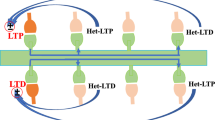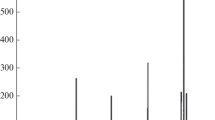Abstract
The calculation of the coefficient of correlation between changes in the direct (D) and monosynaptic (I) components of the pyramidal tract (PT) response made it possible to establish the presence of a positive linear association between conditioned reflex changes in synaptic efficiency and the shifts in cellular excitability observed at the same time. The coincidence of the maximal strength of this association with the greatest increase in cellular excitability which is dependant on the activation of motivatiogenic structures points to the role of these subcortical structures in the launching of intracellular reactions which leads to the formation of the overall molecular substrate which underlies interaction of membrane and synaptic mechanisms. The preceding of the greatest enhancement of synaptic efficiency by the maximal manifestation of the interaction attests to the contribution of this process to the manifestation of the principal mechanism of the conditioned reflex (CR).
Similar content being viewed by others
References
R. G. Kozhedub, “Prolonged changes in synaptic efficiency and cellular excitability during learning,”Zh. Vyssh. Nervn. Deyat.,39, No. 4, 675–681.
R. G. Kozhedub, “The functional role of increase in cellular excitability and synaptic efficiency in the new cortex during learning,”Zh. Vyssh. Nervn. Deyat.,42, No. 4, 664–671 (1992).
R. G. Kozhedub, “The correlational association between changes in cellular excitability and synaptic efficiency during posttetanic reorganizations in the cortex,”Zh. Vyssh. Nervn. Deyat.,43, No. 1, 92–99 (1993).
M. N. Livanov,The Spatial Organization of Cerebral Processes [in Russian], Nauka, Moscow (1972).
I. V. Pavlova,The Interaction of Neurons of the New Cortex in the Case of Tonic Conditioned Reflexes [in Russian], Nauka, Moscow (1990).
B. A. Ballyk and J. W. Coh, “Role of extracellular K+ in the induction of hippocampal long-term potentiation,” in:Abstr. III IBRO World Congress of Neuroscience, Montreal (1991), p. 303.
G. L. Collingridge and T. V. P. Bliss, “NMDA receptors — their role in long-term potentiation,”Trends in Neurosci.,10, No. 7, 288–293 (1987).
K. G. Reymann, H. Matthies, U. Frey, and T. Behnish, “The dependance of LTP-maintenance on activation of metabotropic glutamate and dopamine receptors as well as protein kinases in rat hippocampal neurons,” in: Abstr. III IBRO World Congress of Neuroscience, Montreal (1991), p. 305.
S. S. Smith and J. Li, “NMDA-induced stimulation of phosphatidylinositol turnover in neonatal rat cerebellum is dependant upon production of nitric oxide,” in: Abstr. III IBRO World Congress of Neuroscience, Montreal (1991), p. 365.
X. Xie, T. W. Berger, and G. Barrionuevo, “Long-term potentiation of NMDA receptor mediated synaptic transmission at the perforant path-granule cell synapse in rabbit hippocampal slices,” in: Abstr. III IBRO World Congress of Neuroscience, Montreal (1991), p. 304.
A. Wieraszko and G. F. Ball, “NMDA receptor-independant, long-lasting synaptic facilitation in avian hippocampal slices,” in: Abstr. III IBRO World Congress of Neuroscience, Montreal (1991), p. 305.
Author information
Authors and Affiliations
Additional information
Translated from Zhurnal Vysshei Nervnoi Deyatel'nosti imeni I. P. Pavlova, Vol. 43, No. 3, pp. 507–513, May–June, 1993.
Rights and permissions
About this article
Cite this article
Kozhedub, R.G. The correlation between changes in synaptic efficiency and cellular excitability during the development of a conditioned reflex analog. Neurosci Behav Physiol 24, 381–385 (1994). https://doi.org/10.1007/BF02359788
Received:
Revised:
Issue Date:
DOI: https://doi.org/10.1007/BF02359788




